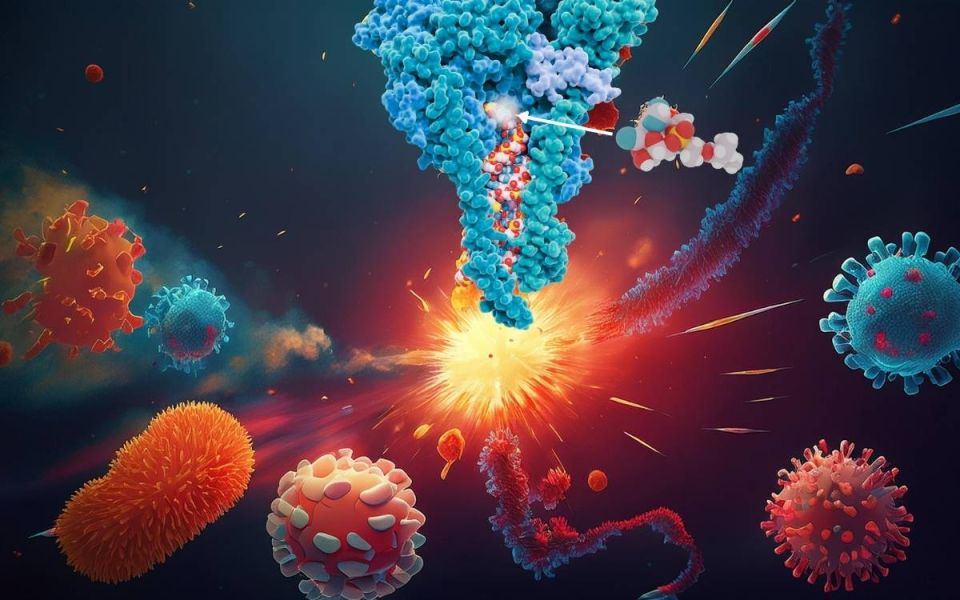Can We Outsmart Viruses by Targeting Their Shared Weakness?

This week, we’re looking deep into the microscope. Really deep. Cells are the basic unit of life, and most contain all the parts needed to live, move, get energy, and replicate. Viruses, on the other hand, have almost none of those things. Since they are missing the parts needed to live, they are usually considered “not alive.” Instead, viruses are minuscule machines made out of chemistry that rely on host cells to reproduce. They don’t have a power source or the machinery needed to copy themselves. Some viruses don’t even have DNA - the genetic code living cells use as the blueprint for making things. These viruses instead use RNA as their genetic code, which needs different machinery to reproduce.
Many of the most famous and dangerous RNA viruses that infect humans utilize the same cellular machinery. These viruses, called Mononegavirales, include HIV, influenza (the flu), coronaviruses (including COVID-19), rabies, ebola, measles, and respiratory syncytial virus (RSV). When they infect a cell, the virus tells the cells to build a special RNA-replicating machine called an RNA-dependent RNA polymerase. This specialized protein enzyme replicates the viral RNA like a Xerox machine. This is a rare piece of hardware, and all the viruses mentioned above instruct cells to make an RNA-dependent RNA polymerase that looks almost exactly like its relatives. On its own, this is a fun fact that can impress your family and friends at the next virus-fact-themed dinner party, but it’s really exciting when you think about fighting the viruses.
Shared characteristics across different species are exciting because a medicine that works against one virus might work against many of them. Think of it like hand sanitizer, it doesn’t just kill one or two kinds of bacteria, but 99.9% of them! Unlike hand sanitizer, though, targeting the RNA-dependent RNA polymerase wouldn’t kill helpful bacteria - or dry out your hands! This is, in fact, exactly what scientists are finding! Remdesivir is a medication approved for the treatment of COVID-19; it works by targeting the RNA-dependent RNA polymerase, but started life as an experimental treatment for Ebola! Modified versions of the medication continue to be explored for treatment of other Mononegavirales, including RSV. Medications derived from Remdesivir are exciting not only because they help cells fight an infection from the inside, but because they may work on a broad spectrum of viruses. With the help of clinical research, we might be able to magnify the effects of antiviral medications.
Staff Writer / Editor Benton Lowey-Ball, BS, BFA
Click Below for ENCORE Research Group's Enrolling Studies
References:
Amarasinghe, G. K., Aréchiga Ceballos, N. G., Banyard, A. C., Basler, C. F., Bavari, S., Bennett, A. J., ... & Kuhn, J. H. (2018). Taxonomy of the order Mononegavirales: update 2018. Archives of virology, 163, 2283-2294. https://www.ncbi.nlm.nih.gov/pmc/articles/PMC6076851/
Fearns, R., & Deval, J. (2016). New antiviral approaches for respiratory syncytial virus and other mononegaviruses: Inhibiting the RNA polymerase. Antiviral research, 134, 63-76. https://www.sciencedirect.com/science/article/pii/S0166354216303527
Gordon, C. J., Tchesnokov, E. P., Woolner, E., Perry, J. K., Feng, J. Y., Porter, D. P., & Götte, M. (2020). Remdesivir is a direct-acting antiviral that inhibits RNA-dependent RNA polymerase from severe acute respiratory syndrome coronavirus 2 with high potency. Journal of Biological Chemistry, 295(20), 6785-6797. https://www.ncbi.nlm.nih.gov/pmc/articles/PMC7242698/
International Committee on Taxonomy of Viruses Executive Committee. (2020). The new scope of virus taxonomy: partitioning the virosphere into 15 hierarchical ranks. Nature Microbiology, 5, 668–674. https://www.nature.com/articles/s41564-020-0709-x
Jiang, Y., Yin, W., & Xu, H. E. (2021). RNA-dependent RNA polymerase: Structure, mechanism, and drug discovery for COVID-19. Biochemical and biophysical research communications, 538, 47-53. https://www.ncbi.nlm.nih.gov/pmc/articles/PMC7473028/
Yan, V. C., & Muller, F. L. (2020). Advantages of the parent nucleoside GS-441524 over remdesivir for Covid-19 treatment. ACS medicinal chemistry letters, 11(7), 1361-1366.https://www.ncbi.nlm.nih.gov/pmc/articles/PMC7315846/
Xie, J., & Wang, Z. (2021). Can remdesivir and its parent nucleoside GS-441524 be potential oral drugs? An in vitro and in vivo DMPK assessment. Acta Pharmaceutica Sinica B, 11(6), 1607-1616. https://www.ncbi.nlm.nih.gov/pmc/articles/PMC8245906/



